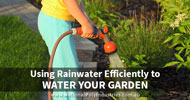
If you live in an area that receives much rainfall all year round, then you may not even need to worry about watering your garden. For most though, there will be drier months of the year that require you to water your garden and lawn.
Keep in mind that water sustainability covers how your water is used just as much as its source, such as harvesting rainwater. This article will look at how often you should water and how to water your plants more efficiently to not have it wasted.
How Often Should You Water?
It is important to encourage deeper roots to your plants. This can be accomplished by providing your plants with good top soil that is protected from washing away. Your soil shouldn’t be salty or full or solid, and a clay-rich soil at the optimum root depth of your plant is ideal which holds water much better. You want to encourage your plants to grow their root systems deeper than the first few centimetres of topsoil.
Secondly, watering every day or many times a week, encourages roots to remain near the surface. Given constant watering will supply water at the surface, your plant won’t need to dig its root system deeper into the soil, where it is cooler and can access more water during hotter and drier periods.
To encourage deeper and more healthy root systems, it is therefore important to water regularly, but water longer. Try not to water beyond the root depth. It is also important though that your soil can retain water, that it doesn’t just seep into the top soil and flow out the side of your garden. Setting up appropriate barriers around your garden, installing underground irrigation and/or adding mulch can all help.
Watering Your Plants Efficiently
Many people often saturate their plant with water, leaves and all. It is better to keep leaves dry, as being wet can promote mould and disease. What is more important is getting water to the root system of your plants which is where plants need it.
Drip irrigation delivers water very efficiently. Rather than feeding water directly onto the plant, it is good to saturate the soil immediately surrounding it. This allows the water to seep in, get to the roots and promote their growth and helps to prevent mould and disease.
Sprinkler systems can deliver water over a large area at relatively low cost, but are inefficient where you have small gardens. You should consider your garden setup and perform some research on the best type of irrigation for your plants to work out the best irrigation solution.
Protecting Against Water Evaporation
Evaporation is a main contributor to loss of water in your soil. Thankfully, you can take steps to minimise evaporation and improve the efficiency of your watering:
- Mulch acts as a protective blanket on your soil and keeps your topsoil cooler, which helps to prevent evaporation and keep your soil moist.
- Wind will evaporate water much more quickly. Installing barriers of some sort to block wind, or strategically placing water hungry plants out of the wind, will make your watering go further.
- Shade helps to keep the Sun’s heat off your plants and surrounding soil, although some plants love full sunlight so such may not always be ideal.
- Watering in cooler times of the day such as in the morning or evening helps reduce evaporation.
Using Harvested Rainwater
While many make use of their mains water in gardens, installing rainwater tanks is a great way to be more water efficient. Such solutions end up being cheaper than mains water use in the long run, and help to preserve waterways and offer protection against your gardens drying out during times of imposed water restrictions. If you are interested in a cost-effective solution, contact National Poly Industries for a good deal.
 If you live in an area that receives much rainfall all year round, then you may not even need to worry about watering your garden. For most though, there will be drier months of the year that require you to water your garden and lawn.
Keep in mind that water sustainability covers how your water is used just as much as its source, such as harvesting rainwater. This article will look at how often you should water and how to water your plants more efficiently to not have it wasted.
If you live in an area that receives much rainfall all year round, then you may not even need to worry about watering your garden. For most though, there will be drier months of the year that require you to water your garden and lawn.
Keep in mind that water sustainability covers how your water is used just as much as its source, such as harvesting rainwater. This article will look at how often you should water and how to water your plants more efficiently to not have it wasted.

